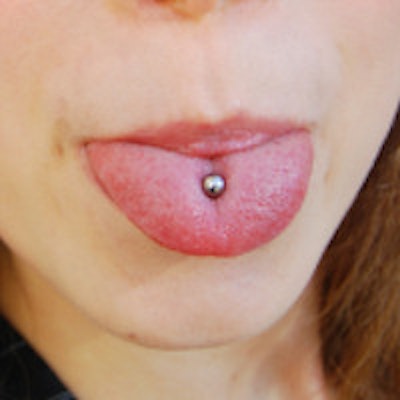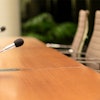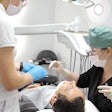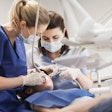
When DrBicuspid.com posted a picture on its Facebook page of a wide, clear lip piercing plug that offered a view of the wearer's dentition, it elicited a record-breaking response, reaching nearly 41,000 people and receiving hundreds of comments and shares. It also received 26 likes, so not everyone had a negative response to it.
But many were harsh. "Gross!" or "disgusting!" or expressions of skepticism that the image was doctored were common, but so were earnest concerns about the person's oral health.
"I would imagine the lower anterior tissue would [be] in danger of drying out (similar to maxillary anterior tissue with mouth breathers)," one person commented. "If so, this could lead to increased caries, increased calculus, and other problems."
Of course, this was no ordinary piercing.
"One of the most important things I need to share with you, is that what you saw there, the picture that got such a strong response, is not all that common," Elayne Angel, president of the Association of Professional Piercers (APP) and author of The Piercing Bible -- The Definitive Guide to Safe Body Piercing, said in an interview with DrBicuspid.com.
"And certainly not at all common to do as an initial piercing. My point is, normally a piercing in the lip is a very small puncture and a small ornament is worn in it. It's much less shocking, visually, and much less likely to run into trouble with a small ornament in the region. It's not at all an ordinary practice for someone to create such a huge opening anywhere in the body as a piercing that would be done initially. Normally piercings are done with small gauges."
But even small gauges can cause problems in the oral cavity -- particularly if they're done incorrectly.
"One of the biggest problems and one I continually see involves the jewelry," Betsy Reynolds, RDH, told DrBicuspid.com. "If the bar bell in a tongue piercing is too long, and the barbell can touch the surface of the teeth, that's when you're going to get chipping, recession, and bone loss, especially on the mandibular anteriors, because the facial and lingual plates are so thin. So the bone loss can go very quickly."
Reynolds has worked extensively with the APP to educate professional piercers about oral health in relation to piercing. Both she and Angel emphasized the importance of proper sizing in regard to tongue piercing.
"The issues I mentioned can be remedied if the piercing is placed properly and the jewelry is downsized after the tongue swelling decreases," Reynolds explained. "The placement of the piercing also has to be accurate in regard to its resting position. It should tip toward the back of the throat a little bit while still avoiding having the bead or jewelry hit the lingual plate of the teeth."
Proper placement for tongue and labret piercings is one of the primary topics that she has been educating the piercing community about. Labret piercings that have a disk-shaped backing inside of the mouth provide significant challenges.
"That's probably, in my opinion, one of the most technique-sensitive piercings because you have to make sure the disk, which rests inside the lip or cheek, is perfectly flush with the tissue," Reynolds explained. "If it's off by even a millimeter, it can act like a shovel, as I say, and divot out the gingiva, and that's where you get recession."
Getting dentists involved
Professional piercers will understand these risks and be able to explain them to their clients. Many have symbiotic relationships with oral health professionals. "Most cultivate a network of piercing-friendly medical professionals," Angel said. "Someone they can refer the client to that won't just say, 'Oh no, that's a terrible idea' or 'You have to take that out,' but will become educated and offer more suitable advice."
These relationships are built on familiarity with oral health issues related to piercing and a willingness to guide a patient interested in piercing. "For example, with infection, it is often medically contraindicated to remove the jewelry, where it's necessary to leave quality jewelry of the appropriate size in place to allow for drainage," Angel said. "You can end up with an abscess from pulling out jewelry in a patient's infection."
She also warned that simply saying to a patient, "Don't do that," in regard to piercing is often ineffective because they will often do it anyway. "If they're armed with more information, like knowing about jewelry made of dental acrylic instead of metal, that are more tooth-friendly than metal, the dental professional can give better guidance that will likely result in better outcomes instead of offering advice that a patient simply isn't going to follow," Angel explained. "It's an intermediate step in trying -- they may say, 'My first suggestion is to take that out, and if you're not, please look for a dental acrylic option.' "
Materials are particularly important. The jewelry should be high-quality TI-6 titanium, 24-karat gold, or niobium. There is also consensus on the appropriate age for piercing. "The APP is very strong on this and I back them 150%, no piercing should be done before the age of 16," Reynolds said. "When I see babies that have been pierced, 9 out of 10 times, they're done with a gun and 9 out of 10 times, the studs that are used in a piercing gun have leachable nickel underneath the gold plating."
“[Piercing] guns are horrible because you can't sterilize them between patients or clients.”
Reynolds suspects that high -- and increasing -- rates of nickel allergies could be related to piercing. "It's more prominent in girls than boys, and the reason, we think, has a lot to do with punching a nickel-laden material into a baby's earlobe when the immune system is still developing and looking for anything to attack."
Self-piercing is the worst option, but the use of a piercing gun also is hazardous for piercing clients of any age. Unfortunately, they are less than $100 and commonly found at mall piercing stalls. "These guns are horrible because you can't sterilize them between patients or clients," Reynolds warned. "So if somebody is going to a mall piercing station, they're going to be biologically exposed to every blood-borne pathogen from the person who sat in the chair before them."
Reynolds would not have been able to provide advice like this 20 years ago. Then she included four slides about tongue piercing in the continuing education course she hosted for the Iowa Dental Hygienists' Association with an overwhelming response. When they asked her for a full course on the topic, she did not know where to begin. "I didn't even know anybody with a tongue piercing," she said. As she and a friend sat at a diner and mulled over going to a tattoo parlor ("Although, I know that sounds ridiculous now," she said), the waitress approached -- and she had a tongue piercing.
Armed with the knowledge of a reputable piercing establishment, they spoke with the piercing professional there and got permission to take photos of the procedure. Soon after, Reynolds was asked to speak at the first AAP meeting. She has spoken at every one since. "I have done some articles on wound healing, head and neck concerns, piercing healing dynamics, etc.," Reynolds said. "They've been very forthcoming in their realm of piercing and very accepting of what I've given them, so it's been a very positive alliance. A few years ago they gave me the APP's president award, and I think I'm the only nonpiercer to receive it."















